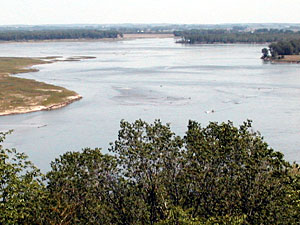|
Photos
Your Voice
|
Water levels up and down on Missouri River
August 14, 2003
For the last three days Missouri River levels have decreased by as much as a foot-and-a-half. In July a federal judge ordered the change in level for the river in Iowa, Nebraska and Missouri. The Army Corps of Engineers complied with the order just this week. Environmentalists call it a victory for endangered species.
Sioux Falls, S.D. — The federal judge demanded that the Army Corps of Engineers drop water levels on the Missouri River. The judge said the Corps was to release less water from one of the huge dams in South Dakota. The Corps challenged that order. Last week a federal judge in Minnesota ruled the Corps had to comply.
Eric Eckl, spokesman for the conservation group American Rivers, says the fact the Army Corps is complying at all is a victory. Eckl says the lower water levels for a 700-mile stretch through Iowa, Nebraska and Missouri creates more than sand bar habitat for endangered birds.
"It creates shallow water habitat that encourages the survival of the endangered pallid sturgeon, as well as many other popular sport fish species such as bass and walleye and catfish in the river," Eckl says. "The lower river is also a more attractive destination for recreational use under these circumstances."
 | |||
The Missouri River has six huge dams in North and South Dakota that control water levels for the Missouri River. Paul Johnston, a spokesman for the Army Corps of Engineers in Omaha, says the river there will drop by a foot-and-a-half.
"The marinas have had to put channel blocks in to keep water in their boat basin so their docks don't get all bent up and break," Johnston says. "The birds have already begun leaving their nesting grounds. So the net affect is it'll be annoying for the marinas and the barge operators and really not do very much good for the fish or the birds."
There are two federal laws that dictate how the Army Corps must control water levels. One is the flood control act of 1944. The other is the Endangered Species Act. The two are in constant conflict. That's because one regulates water flow to prevent flooding while the other protects species that need a high and low water flow during different times of the year. That's what the river species need to survive and thrive.
The Army Corps of Engineers relies on a complex document to manage water flows on the Missouri River. They call it the "Master Manual". Right now that manual guarantees consistent water levels down stream. Environmentalists and recreation facilities up stream want the focus to change. Every year someone files a lawsuit to change the flow of the river.
American River's spokesman Eric Eckl says there needs to be a permanent solution but he's suspicious of motives.
"We believe the Army Corps' next approach is to try and write a new master manual and see if they can paper their way out of making flow changes ina way that won't be struck down by the courts," Eckl says.
The Army Corps' Paul Johnston says they plan to release a new management plan this winter and operate the river differently by next spring. But he says it'll take cooperation and compromise.
"We have some great opportunities for some fish and wildlife habitat mitigation," says Johnston. "I have a real concern that if we continue in a mode of everyone throwing rocks at one another we're not going to get the kind of long term financial and political support we're going to need to really do something along the river to really help these species."
On Friday, the Army Corps of Engineers will begin releasing more water from the Missouri River dams. That's because the initial court order expires August 15.
South Dakota Governor Mike Rounds is trying a different approach. He wants other governors to attend a river summit next month. He's also inviting environmentalists and the corps. He believes they can find a compromise. It seems the only thing all sides agree on is keeping the issue out of the courts.
|
News Headlines
|
Related Subjects
|

